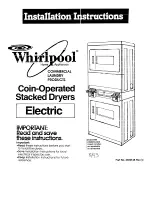
Installation Guidelines
11/18
page 6 of 7
For more information, contact your local Mannington representative or visit manningtoncommercial.com
Crafted with purpose
3.
Amtico RP18:
A solvent-free 1-component silane polymer-base adhesive. Moisture limits per ASTM F-1869 of 10 lbs.
maximum MVER and/or 95% relative humidity per ASTM F-2170 and a pH limit of 12. Amtico RP18 works well over
porous subfloors using a 1/16” x 1/32” x 1/32” U-notch trowel with an approximate spread rate of 250 sq. ft. per gallon
and non-porous subfloors using a 1/16” x 1/32” x 5/64” U-notch trowel with an approximate spread rate of 350 sq. ft.
per gallon. It is recommended for use in all areas subject to some heat and moisture variations, like what may be
found adjacent to sunny windows and bathrooms. Amtico RP18 must be used for installing LVF in wet areas such as
locker rooms and should also be used for areas with high point loads and direct sun exposure. See adhesive spec and
label for details.
4.
XpressStep Spray Adhesive:
Water based spray adhesive recommended for the installation of Mannington
Commercial LVF over porous and non-porous subfloors. Moisture limits are 10 lbs. maximum MVER or 95 % relative
humidity with a pH maximum limit of 11. Spread rate approximately 150-185 sq. ft. per can.
XpressStep Premium Spray Adhesive:
Moisture limits are 10 lbs. MVER or 98% relative humidity with a pH maximum
limit of 12. Spread rate approximately 150-185 sq. ft. per can.
XpressStep Spray Adhesives
may be used under hospital beds, operating room tables and heavy rolling loads.
Mannington Commercial will not assume responsibility for floor covering failure due to hydrostatic pressure or moisture
vapor emission. The final responsibility for determining if the concrete is dry enough for installation of the flooring
lies with the floor covering installer. The adhesives are designed to be moisture resistant to accommodate the water
of hydration contained in new slabs or initial mixing; they are not to be considered remedial solutions to concrete
subfloors with a history of moisture problems.
Important:
Temperature directly affects adhesive working and setting times. Warmer temperatures shorten working
times and colder temperatures lengthen working times of adhesive. Follow instructions on container for proper
application.
Installation
Adhesive application: Follow the instructions on the adhesive labels.
1. Use a trowel with appropriate notch size. Do not use worn trowels (approximately 600 sq. ft. usage on concrete).
2. Spread adhesive evenly with proper trowel held at 60 degree angle, avoiding skips or voids and excessive adhesive
application.
3. Only spread sufficient adhesive that can be covered within the adhesive working time.
4. Tiles/planks must be placed into adhesive as specified (follow label directions).
5. Install rows to chalk line making sure tiles/planks are precisely aligned with chalk line and adjacent tiles.
6. Randomly check tiles/planks for complete coverage of adhesive onto back of tile, especially near the end of each
adhesive spread. If there is little or no adhesive transfer, or if the adhesive has flashed off or skinned over, adequate
bonding may not be possible. Scrape the flashed-off adhesive from the floor, and spread fresh adhesive.
7. If tiles/planks shift, use releasable masking tape diagonally over seams to keep tiles tight and aligned.
8. Wet-set application: Do not work on top of freshly installed flooring. This will minimize tile/plank shifting and adhesive
displacement, and prevent wet adhesive from oozing up and getting onto the surface of the new flooring.
9. The floor must be rolled in both directions using a 100-lb. 3-section roller. Roll floor as soon as conditions permit,
without the tiles/planks sliding or adhesive bleeding to the surface. Roll floor again, 90 degrees to the first direction,
within 1 hour. Adhesives should provide 100% uniform adhesive transfer (no visible trowel ridges) onto the back of the
tile/plank, and not cause adhesive to squeeze out between tiles/planks. Pressure Sensitive Adhesive will not transfer
100% to the backing of the tile/plank. Be sure not to exceed the 3 hour working time.
10. Clean excess adhesive as you install, before it is allowed to dry. Use a soapy, clean, soft cloth to remove wet excess
adhesive.

























